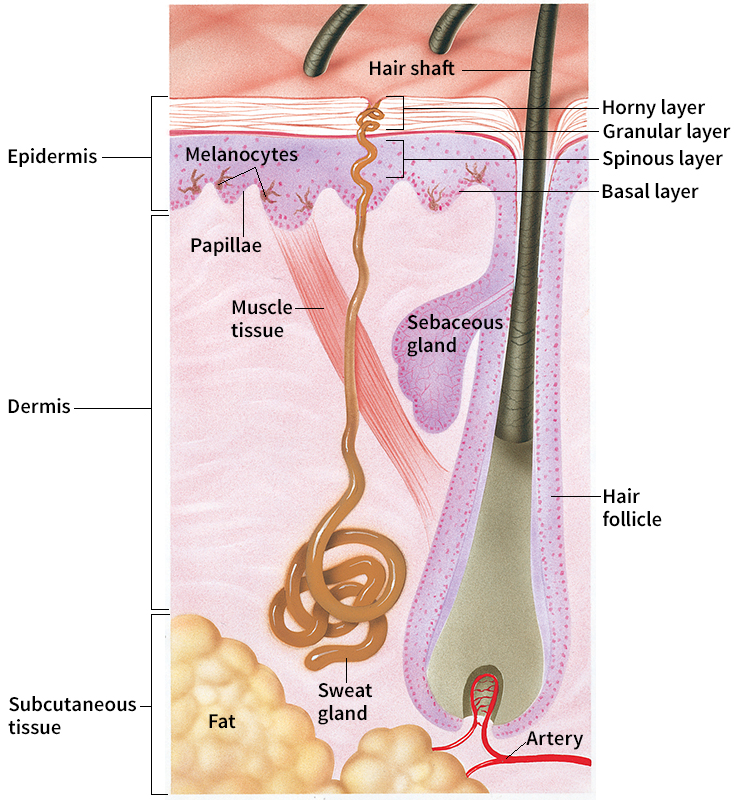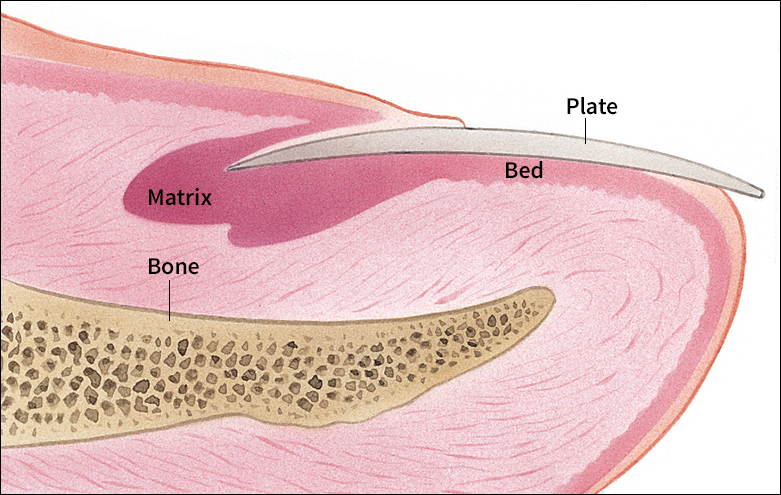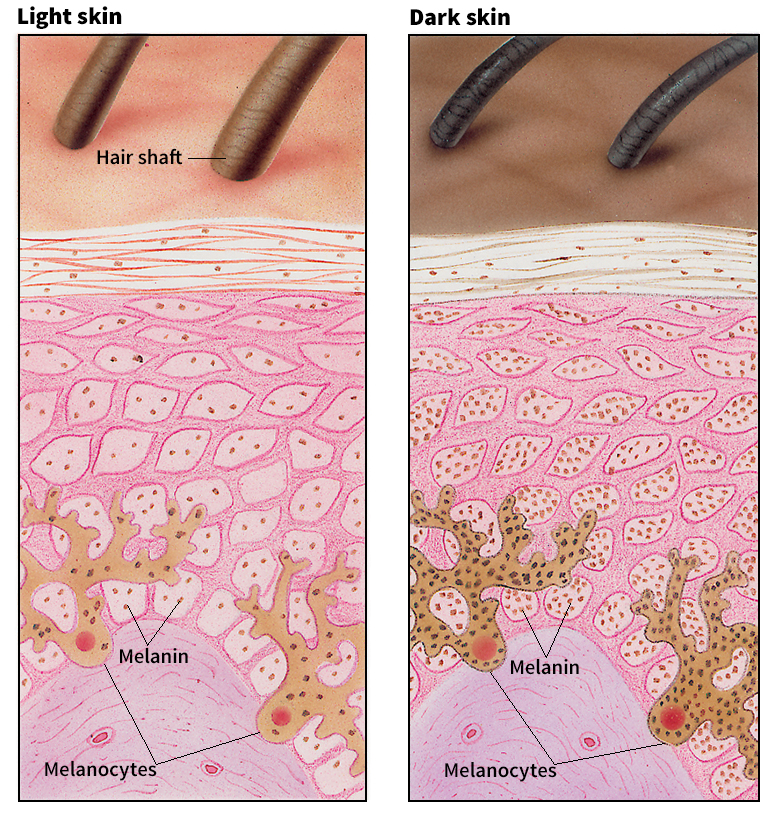Skin is the organ that covers the bodies of human beings and many other animals. In human beings, the skin protects the body in a wide variety of ways. For example, the skin is almost completely waterproof and so prevents the escape of the fluids that bathe body tissues. It also prevents bacteria and chemicals from entering most parts of the body and is an important part of the body’s defense against disease. The skin protects underlying tissues from harmful rays of the sun.
In addition, the skin helps keep the internal temperature of the body within normal levels. Glands in the skin release sweat when a person becomes overheated. The sweat evaporates and so cools the body. When a person becomes too cool, the body retains heat by narrowing the blood vessels in the skin. As a result, the flow of blood near the surface of the body decreases, and the body gives off less heat. The skin has many nerve endings that are sensitive to cold and heat, as well as pain, pressure, and touch.
The skin is the largest organ of the human body. If the skin of a 150-pound (68-kilogram) adult male were spread out flat, it would cover about 20 square feet (1.8 square meters).
This article deals mainly with the skin of human beings. It discusses the structure and color of the skin and various skin disorders. The last section describes the skin of other animals.
Structure of the skin
The skin has three layers of tissue: (1) epidermis, (2) dermis, and (3) subcutaneous tissue. The epidermis, the outermost layer, is about as thick as a sheet of paper over most parts of the body. The dermis, the middle layer, is between 15 and 40 times as thick as the epidermis. The subcutaneous tissue, the innermost layer, varies greatly in thickness among individuals. In all people, however, the subcutaneous tissue is much thicker than the epidermis and dermis. In addition to these tissues, the skin includes the hair, nails, and certain kinds of glands.

Epidermis
has four layers of cells. From the outermost to the innermost, they are the horny, granular, spinous, and basal layers. The horny layer consists of between about 15 and 40 rows of dying cells. These cells are filled with a tough, waterproof protein called keratin. The granular layer consists of one or two rows of dying cells that contain small grains of a substance called keratohyaline. The spinous layer is composed of between about 4 and 10 rows of living cells that have spinelike projections where the cells touch one another. The basal layer is also made up of living cells. It consists mainly of a single row of tall, narrow basal cells. The basal layer also includes cells called melanocytes. These cells produce a brown-black pigment called melanin.
The basal cells divide continually and form daughter cells. Some daughter cells remain in the basal layer. Others move toward the outer surface of the skin and eventually form the upper layers of the epidermis. These cells are called keratinocytes, and they produce keratin. Keratin is found only in the epidermis, hair, and nails. Keratin makes the skin tough. It also prevents fluids and certain substances from passing through the skin. As the keratinocytes move upward through the epidermis, they become filled with more and more keratin. By the time they reach the surface of the skin, they have died and become flat and dry. Eventually, they are shed as thin flakes.
Dermis
is made up chiefly of blood vessels, nerve endings, and connective tissue. The blood vessels nourish both the dermis and the epidermis. The surface of the dermis has many tiny elevations called papillae that fit into pits on the undersurface of the epidermis. They help connect the dermis to the epidermis. The papillae contain nerve endings that are sensitive to touch. The nerve endings are especially numerous on the palms and fingertips.
Subcutaneous tissue
consists mainly of connective tissue, blood vessels, and cells that store fat. The subcutaneous tissue helps protect the body from blows and other kinds of injuries. It also helps retain body heat. The amount of fat in the subcutaneous tissue may increase after a person overeats. If the body needs extra food energy, it breaks down this stored fat.
Hair, nails, and glands.
Hair, nails, and the glands in the skin are called epidermal appendages. They are formed from the basal cells of the epidermis.
Hair.
Most of the skin is covered by tiny hairs. The scalp and some other parts of the body have large hairs. The palms of the hands and the soles of the feet have no hair at all. Part of each hair extends below the surface of the skin. This part lies in a baglike structure called the follicle. The end of the hair, called the bulb, is the only living part of a hair. It lies in the dermis or subcutaneous tissue. The cells of the bulb divide rapidly and account for the growth of a hair. The hair cells above the bulb contain a form of keratin called hard keratin.
Nails.
A nail has three parts, the matrix, plate, and bed. The matrix lies under the surface of the skin at the base of the nail. Most of the matrix is covered by skin. But part of the matrix forms a whitish half moon that can be seen at the base of the nail. The plate is the hard outer part of the nail. It consists of many layers of flat, dead cells that contain keratin. The bed lies under the plate. The cells of the bed and plate are formed in the matrix. Newly formed cells push the older ones toward the tip of the nail. This pushing process results in the growth of the nail.

Glands.
The skin has two kinds of glands, sebaceous and sweat. Sebaceous glands empty into hair follicles. These glands secrete an oil called sebum, which lubricates the hair and the surface of the skin.
There are two types of sweat glands, eccrine and apocrine. Eccrine glands produce the sweat that cools the body. They are located throughout the surface of the skin but are particularly numerous on the forehead, palms, and soles. Some eccrine glands produce secretions continually. Others become active only when a person is under physical or emotional stress. Eccrine glands release their secretions onto the surface of the skin. Apocrine glands produce sweat that has no important function. Most of these glands are in the armpits and around the genitals (external sex organs). They release their secretions into hair follicles.
Sweat is odorless until after it has been broken down by bacteria on the surface of the skin. After this process occurs, sweat has what many people consider an unpleasant odor. Apocrine sweat smells stronger than eccrine sweat, and so the armpits and genital area are the chief sources of body odor.
Skin color
The color of the skin varies greatly among population groups and individuals. Skin color depends mainly on the amount of the brown pigment melanin produced in the skin. Melanin is formed by the melanocytes in the epidermis. All people have about the same number of melanocytes. However, the melanocytes of dark-skinned people produce more melanin than do those of light-skinned people. The amount of melanin produced in each person’s skin is determined mainly by heredity. However, exposure to sunlight increases the production of melanin, causing light skin to tan. In some cases, melanin builds up in small spots, forming freckles. Most freckles appear on the face and hands. Exposure to sunlight increases freckling.

As a person grows older, the melanocytes produce melanin at uneven rates, which causes some areas of the skin to remain light and others to darken. These dark spots are sometimes called age spots or liver spots. As a person ages, the skin also becomes thinner and drier and so starts to wrinkle and turn scaly. In addition, the skin of an old person bruises and chaps more easily and heals more slowly.
Skin disorders
Inflammation
of the skin is called dermatitis. The most common form of dermatitis is eczema, in which the skin itches and becomes red. The skin may be crusty, or fluid may ooze from it. Atopic eczema is common in children. In most cases, it appears on the face, back of the neck or knees, or inner side of the arms. Contact dermatitis is an allergic reaction to certain substances that a person touches. For example, many people develop itchy blisters after touching poison ivy.
Infections
of the skin are caused by bacteria, fungi, parasites, or viruses. Some of these organisms invade the body in areas where the skin has been broken open. Others remain on the surface of the skin.
Bacteria cause such infections as boils and impetigo. Boils are painful, red lumps filled with pus. Impetigo, which chiefly afflicts children, causes thin blisters to erupt on the skin. The blisters break, and the skin becomes crusty.
Fungi cause such infections as ringworm and athlete’s foot. Ringworm is a general name for several kinds of fungal infections. Common ringworm is characterized by patches of red, scaly, ring-shaped spots. Athlete’s foot is a type of fungal infection in which cracks form in the skin between the toes.
Parasites that infect the skin include lice and scabies mites. Lice infest the hair of the scalp and of other parts of the body. Scabies mites burrow under the surface of the skin. Both lice and scabies mites cause the skin to itch and are contagious.
Viruses cause cold sores, shingles, and other kinds of infections. Cold sores are blisters that usually appear around the mouth. Shingles are painful blisters that occur primarily on the chest and lower back.
Burns
may be caused by heat from fire or other sources or by chemicals, electric shock, or overexposure to sunlight.
Physicians classify the injuries as first-degree, second-degree, and third-degree burns. First-degree burns cause the skin to turn red. These burns affect only the epidermis, and they heal without leaving scars. Second-degree burns cause the skin to blister. They affect the epidermis and part of the dermis and may leave slight scars. Third-degree burns cause the skin to blister or turn black. They damage all three layers of the skin. Some victims require surgery to remove dead tissue and repair the skin. The surgeon may perform a skin graft, in which the damaged tissue is replaced with healthy skin (see Skin grafting).
Sunburns may be mild or severe. Mild sunburn causes the skin to turn red, but the redness disappears in a few hours or days. Severe sunburn produces blistered skin and may be accompanied by chills, dizziness, and fever. Repeated sunburn over a long period may contribute to the development of skin cancer and excessive wrinkling. Sunburn can be avoided by the use of sunscreen lotions, which block out the sun’s burning rays, or by gradual exposure to the sun, which results in suntan. However, repeated suntanning also may contribute to the development of skin cancer and wrinkling.
Tumors
are abnormal growths of cells. Tumors may be benign or malignant. Benign tumors are noncancerous and do not spread through the body. Malignant tumors are cancerous. In a process called metastasis, malignant tumors can invade surrounding tissues or spread to distant parts of the body through the circulatory system.
Benign tumors of the skin include lipomas, moles, and warts. A lipoma is a large, soft lump of fat under the surface of the skin. A mole is a group of pigment cells that form a flat or raised spot on the skin. Most moles are black or brown. Warts, which are caused by a virus, may arise anywhere on the skin. Most warts are raised, rough, and dry, and they do not cause pain. However, plantar warts, which grow on the bottom of the feet, sometimes press against nerve endings in the dermis and so cause pain.
Malignant tumors of the skin include basal cell epitheliomas, squamous cell carcinomas, and melanomas. A basal cell epithelioma is the most common type of skin cancer. It begins as a small, pink lump that slowly enlarges. This type of skin cancer invades and destroys surrounding healthy tissue, but it does not metastasize. A squamous cell carcinoma starts as a thickening or a lump that later breaks down to form an ulcer with a crust. In some cases, this type of skin cancer metastasizes.
A melanoma is the most serious type of skin cancer. It often spreads from one part of the body to another by metastasis. A melanoma may start as a mole that itches or becomes sore, enlarges, grows crusty, and bleeds. A red area, brown spots, or a white ring may appear around the mole. Melanomas may be flat or raised and vary in size and color.
In most cases, skin cancer can be cured if diagnosed and treated in its early stages. Although most skin growths are harmless, any unusual growths should be reported to a physician immediately.
Other skin disorders
include acne, corns, hives, psoriasis, and vitiligo. Acne most commonly afflicts teen-agers. It consists of pimples, blackheads, and other blemishes, which appear mainly on the face, upper chest, and back. A corn is a painful thickening of the epidermis that occurs on the feet. Most corns result from pressure and friction caused by poorly fitting shoes. Hives are small, swollen, white or pink spots that itch. Many cases of hives are caused by allergic reactions to certain foods or medicines. Psoriasis is characterized by thick, raised, red patches of skin that are covered with silvery-white scales. Vitiligo consists of whitish patches of skin that have lost their pigment because the melanocytes have been destroyed.
Animal skin
All animals with backbones have skin that consists of an epidermis and dermis. However, the skin of each species has different characteristics and is especially suited to the animal’s environment.
Only the skin of mammals is covered by hair. Most species have long, thick hair that helps keep them warm. In many species, the hair color blends with the surroundings and helps conceal the animal from enemies. Many animals have nails, claws, or hoofs, which help them obtain food and protect themselves. Claws are longer, sharper, and stronger than nails. Hoofs consist of the same kind of cells that make up nails and claws.
Birds have thin skin covered with feathers. A feather grows in a kind of follicle that resembles a hair follicle. Birds shed their feathers periodically. New feathers continually grow in the follicles and replace those that are shed. A bird has one large oil gland, which is located under its tail. The bird collects the oil from this gland in its beak and spreads it over its feathers. This process, called preening, makes the feathers waterproof.
Fish and amphibians have glands that secrete a slimy substance on their skin. The skin of many species of fish is covered by bony scales. Turtles have shells that consist of an inner layer of bone and an outer layer of skin tissues. Such reptiles as snakes and lizards have dry, scaly skin.

